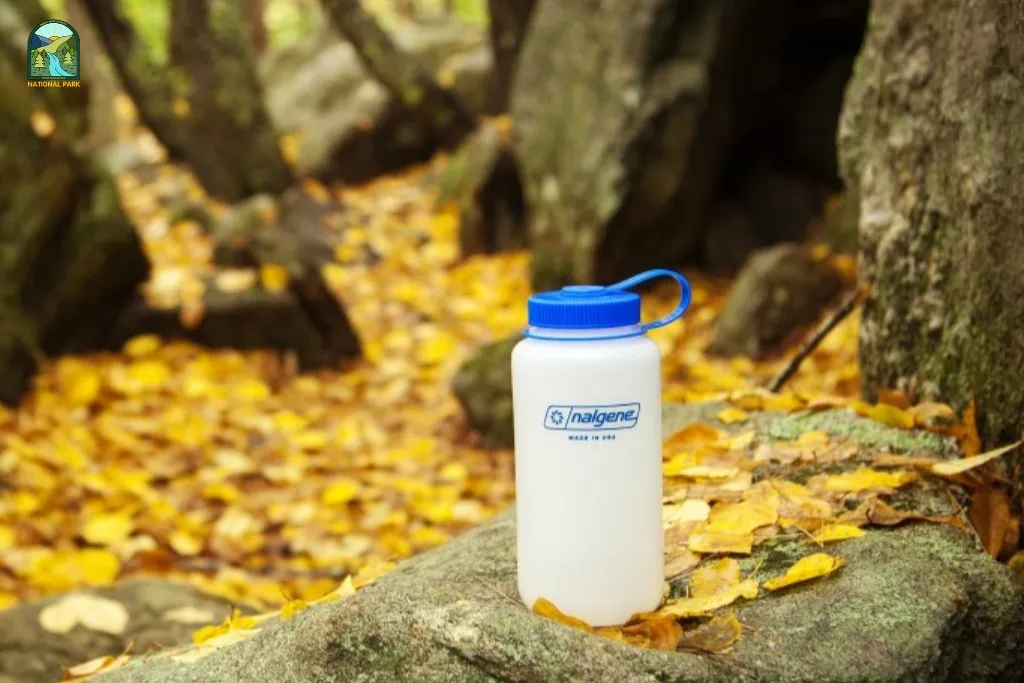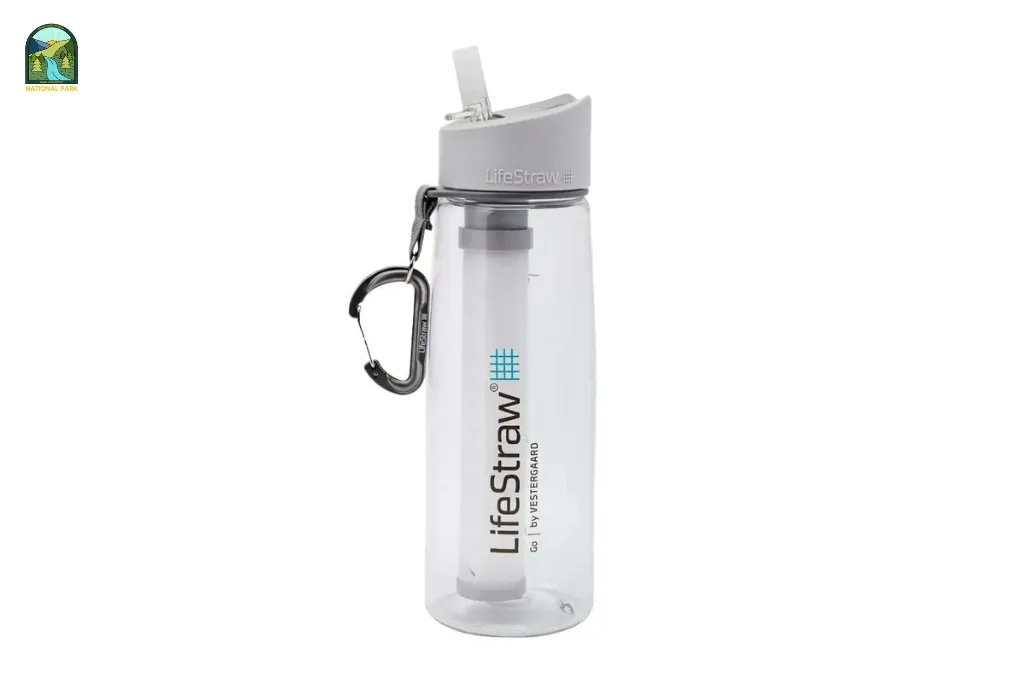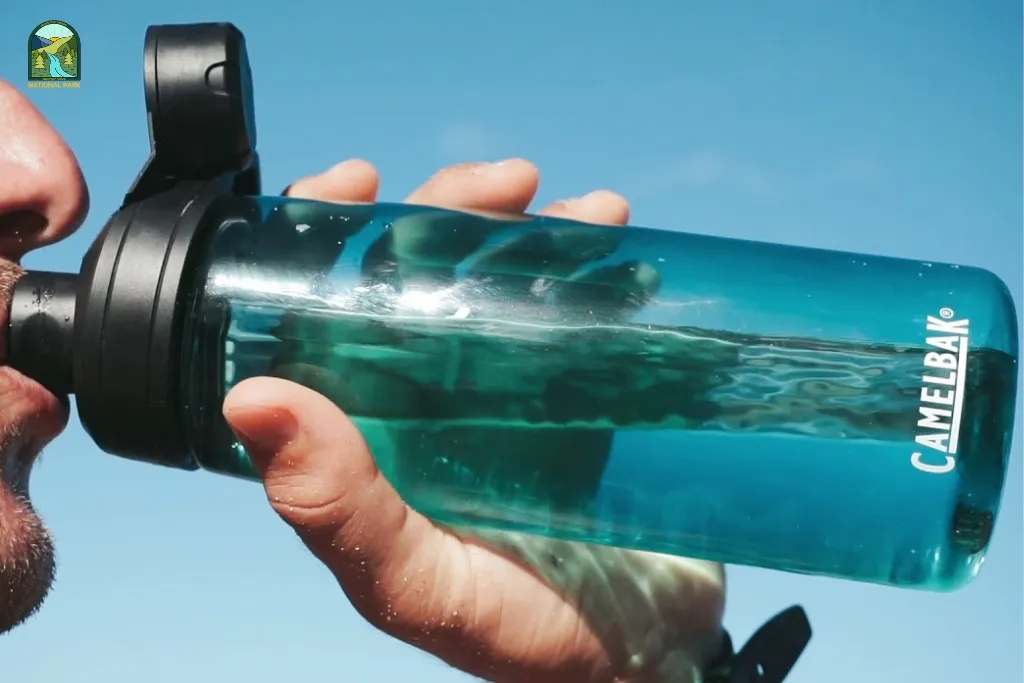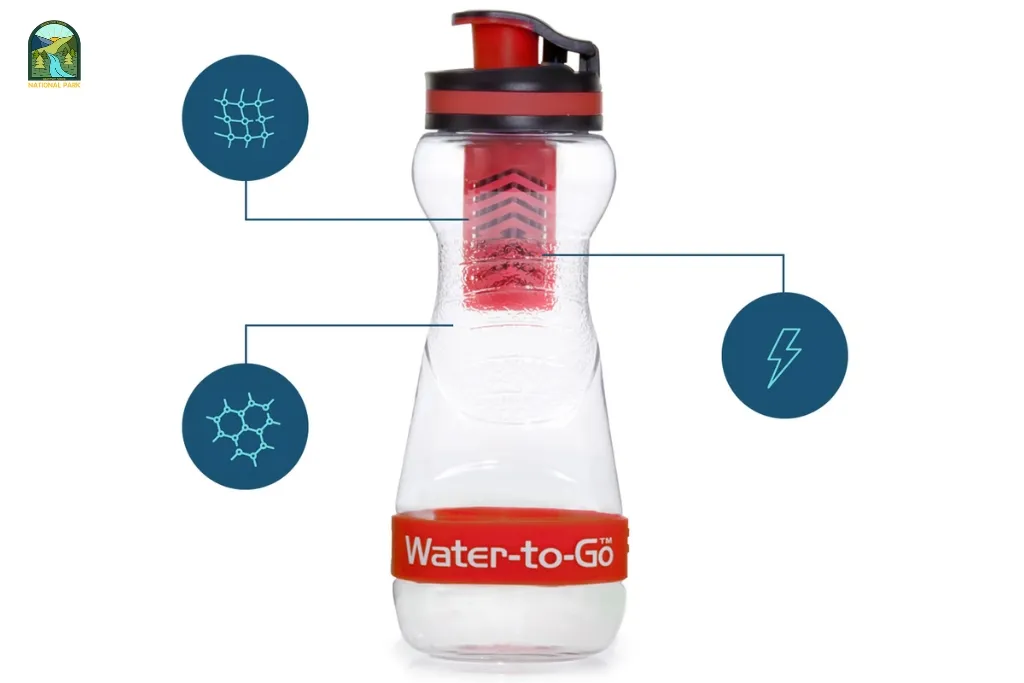I’ve traversed the globe with a trusty companion by my side: the ubiquitous plastic water bottle. It’s become a staple of modern travel, offering convenient hydration on the go. But as I’ve journeyed through diverse landscapes and cultures, I’ve also witnessed the growing concern surrounding our reliance on this seemingly innocuous item. Join me as we delve into the complex world of plastic water bottles, exploring their undeniable convenience alongside their environmental impact.
We’ll uncover the hidden costs of this throwaway culture, discuss healthier alternatives, and discover how small changes in our habits can make a big difference for the planet we all share. Let’s embark on this journey together, raising awareness and seeking solutions for a more sustainable future, one sip at a time with me and nationalparkshops.com!
Nalgene Wide Mouth Ultralite Bottle
- Product Height: 8.25”
- Product Weight: 6.25 oz
- Diameter: 3.5”
- Cap Diameter: 2.5”
- Volume: 32 oz
The Nalgene Tritan Water Bottle is a sturdy and adaptable hydration option crafted from BPA-free Tritan plastic. Its wide opening allows for easy filling and cleaning, fits ice cubes, and is resistant to odors and stains.
The bottle’s robust construction guarantees durability, making it favored for both outdoor adventures and daily use. It includes handy volume indicators for measuring protein shakes and has a leak-proof lid.
Produced in the USA, this plastic water bottle is dishwasher safe and is among the most affordable and well-made water bottles available. Several aspects highlight why this is an excellent choice for athletes and hikers, but its simplicity of design also attracts a wider audience.

Best plastic water bottle with straw: BuildLife Motivational
- Item Package Dimensions: 11.5 x 6.2 x 6.2 inches
- Package Weight: 0.32 Kilograms
- Item Weight: 0.3 Kilograms
The BuildLife Motivational plastic water bottle with straw is designed to encourage hydration throughout the day, making it an excellent choice for fitness enthusiasts and anyone looking to improve their water intake. This bottle features a large 1-gallon capacity, which is perfect for tracking daily hydration goals. The motivational time markers printed on the side serve as reminders to drink water at regular intervals, providing a visual cue that can help users stay on track.
One of the standout features of the BuildLife bottle is its integrated straw, which allows for easy sipping without the need to tilt the bottle, making it convenient for use during workouts or while on the go. The wide mouth opening makes it easy to fill the bottle with ice or water and simplifies cleaning. Additionally, the bottle is made from BPA-free plastic, ensuring that no harmful chemicals leach into your water, a concern often associated with plastic bottles.
However, it’s important to note that while the BuildLife bottle is designed for durability, plastic water bottles can still pose health risks if not properly maintained. Over time, repeated use can lead to scratches and wear, which may allow for chemical leaching. Furthermore, exposure to heat can exacerbate this issue. Therefore, it’s essential to clean the bottle regularly and avoid leaving it in hot environments.
>> Read More: Travel Water Bottle Plastic With Straw

LifeStraw Go Filter Bottle
- Item Package Dimensions: 3.1 x 3.1 x 9.3 inches; 7.84 ounces
- Package Weight: 0.32 Kilograms
- Department: Unisex-Adult
- Capacity: 6.5E+2 Milliliters
The LifeStraw Go Water Bottle features a replaceable filtration straw that purifies water by eliminating bacteria, chemicals, and odors. During our testing over a camping weekend, we sampled water from a marshy area, demonstrating its ability to convert turbid water into safe drinking water through a dual-stage filtration process that targets chlorine and pathogens.
Advertised as a portable option for a water bottle with a filter during emergencies or outdoor activities, the LifeStraw Go is designed for user-friendliness in tough situations. While it comes at a higher price point, its effectiveness in certain situations is impressive. Nonetheless, this makes it less suitable for everyday use, reflecting LifeStraw’s goal of promoting it for occasional rather than frequent consumption.

Best for biking: Simply Pure Purist
- Item Package Dimensions: 8.11 x 5.79 x 3.9 inches
- Package Weight: 0.14 Kilograms
- Special Feature: Bpa Free, Lightweight
- Capacity: 1.4 Pounds
- Item Dimensions: 3 x 3 x 9.5 inches
If you are serious about cycling, you should look into this plastic water bottle from Specialized. It features lightweight and straightforward cap designs that facilitate easy handling, along with a shape that fits well in bike cages, making it ideal for drinking while riding. “The Purist bottle, crafted from insulated plastic like the Nathan mentioned earlier, is considered the standard cycling bottle by most retailers,” states Ronnie Garcia.
Garcia also highlights the advantages of insulated plastic: “Less expensive bottles tend to warp and may not fit properly,” he explains. Ryan Zagata, president of Brooklyn Bicycle Co., adds that the material does not release any bad taste, which is another problem with cheaper plastic options. “It feels like you’re sipping straight from a glass,” he remarks.

Brita Premium water bottle with filter
- Product Dimensions: 3.23″L x 3.23″W x 10.83″H
- Item Weight: 0.48 Pounds
- Special Feature: Bpa Free, Dishwasher Safe, Insulated, Straw
- Shelf Life: 730 Days
The Brita Premium Water Bottle with Filter offers an eco-friendly way to enjoy clean water on the go. Made from hard-sided, BPA-free plastic, it holds 26 ounces and has an activated carbon filter that reduces chlorine taste and odor. Each filter lasts about two months or processes up to 40 gallons, replacing around 300 single-use plastic bottles.
Its convenient design includes an easy-sip straw and a built-in carrying loop for portability. The one-handed push-button lid allows quick access, while the leak-proof design prevents spills, making it perfect for travel, school, or work. This plastic water bottle is also top-rack dishwasher safe for easy cleaning.
However, it’s important to remember that this bottle enhances tap water taste but does not purify it or remove all contaminants. Users should ensure their water source is safe. Overall, the Brita Premium Water Bottle with Filter is a great option for staying hydrated while minimizing plastic waste and enjoying better water taste.

CamelBak Water Bottle With Chute Mag Lid
- Product Dimensions: 9.65″W x 3.75″H
- Item Weight: 6 ounces
- Special Feature: Carrying Loop, Magnetic Cap, Leak-proof when closed
- Age Range (Description): Adult
- Capacity: 24.6 Fluid Ounces
The Chute Mag lid on this Camelbak water bottle makes it very convenient to drink from while on the move. As a highly valued clear plastic water bottle, the Camelbak Chute competes favorably with brands like Nalgene for effective hydration.
Features such as being dishwasher safe and its more compact design make this flask a perfect reusable hydration option for those commuting. We have evaluated this flask in various situations, including yoga sessions and hiking trips.

Water-to-Go – Water Filter Bottle
- Product Dimensions: 3.25″W x 8.5″H
- Item Weight: 121 Grams
- Special Feature: Durable sugarcane bioplastic, Machine washable
- Recommended Uses For Product: Travel, Backpacking, Camping, Hiking
- Capacity: 18.5 Fluid Ounces
When engaging in activities such as backpacking, camping, or hiking, it can often be challenging to find access to clean drinking water. Recent occurrences have further demonstrated that extreme weather conditions can also impede the availability of safe, potable water.
The Water-to-Go product addresses this issue with its innovative filtered water bottle system. This device enables users to collect non-salty water from various sources and consume it safely. With its unique patented filter technology, it effectively eliminates up to 99.99% of harmful contaminants that could potentially cause illness.
The Water-to-Go Water Filter Bottle, designed for hiking, camping, backpacking, travel, and emergency situations, holds 18oz (or 50cl) and has become a vital piece of equipment for numerous outdoor adventurers around the globe.

How were plastic water bottles tested and assessed?
Plastic water bottles undergo various tests to assess their quality, safety, and performance. Here are some of the key tests used to evaluate plastic water bottles:
Material Safety Tests
- Residue on Ignition Test: A sample of the plastic is ignited and the residue left is measured to determine compliance with limits for inorganic residue.
- Heavy Metals Test: The plastic is analyzed to quantify the level of heavy metals present, which must comply with established limits.
- Biological Testing: Extracts of the plastic material are tested for toxicity using agar diffusion, direct contact, and elution tests to evaluate biological reactivity.
- Water Attack Test: The plastic is treated with sulfur dioxide and then filled with water. The alkalinity of the water is measured to check if excessive alkali has leached from the container.
Durability and Integrity Tests
- Impact Resistance Tests: Bottles are tested to simulate accidental drops or impacts during transportation to ensure they can withstand handling without breaking.
- Pressure Tests: Bottles are subjected to pressure tests to evaluate their ability to contain liquids under various conditions and identify potential weak points.
- Leakage Tests: Bottles undergo leakage tests to check the seals and caps for any potential weaknesses by pressurizing the bottles and inspecting for leaks.
- Dimensional Stability Tests: Bottles are evaluated to ensure they maintain their intended shape and size over time for compatibility with packaging.
Advanced Testing Methods
- Container Closure Integrity Testing (CCIT): A critical suite of tests ensuring proper sealing to prevent leaks, maintain sterility, and preserve product efficacy. Methods include vacuum decay, dye ingress, and tracer gas tests.
- Permeation Testing: Evaluates the transmission of gases and vapors through the plastic, which could affect product stability and shelf-life, using tools like oxygen and water vapor transmission rate tests.
- Torque Testing: Measures the rotational force needed to remove or unscrew a cap to ensure it is not too difficult or too loose.
- Seal Leak Testing: Determines the relative seal strength of the cap to maintain freshness and prevent spoilage.
- Weighing “Blown” Bottle Sections: Checks that the various sections of a blown bottle fall within the desired weight range to identify flaws in the bottle-blowing process.
FAQs
Are plastic water bottles safe to drink from?
Plastic water bottles can be safe to drink from, but their safety largely depends on the type of plastic used and how the bottles are handled. Bottles made from BPA-free plastics, such as PET (polyethylene terephthalate), are generally considered safe for single use, as they do not contain harmful chemicals that can leach into the water.
However, repeatedly reusing PET bottles can pose risks, as they may lead to bacterial growth and the potential leaching of antimony, a compound that can cause health issues in higher doses. Additionally, plastic bottles can leach other chemicals like phthalates, especially when exposed to heat or if the bottles are damaged. Recent studies have also raised concerns about microplastics in bottled water, with a significant percentage of brands tested containing these particles, though the health effects of ingesting microplastics remain largely unknown.
To minimize risks, it is advisable to use plastic water bottles only once, avoid reusing them, and keep them away from heat sources. Opting for bottles marked with recycling codes 1, 2, 4, or 5 is recommended, as these are considered safer plastics. For a healthier and more sustainable option, using reusable glass or stainless steel water bottles is a better choice, as they eliminate the concerns related to chemical leaching and help reduce plastic waste.
Can plastic water bottles be reused?
Plastic water bottles can be reused, but there are important considerations to keep in mind regarding safety and hygiene. While some disposable plastic bottles are designed for single use, others are made from thicker materials that can be reused safely if cleaned properly.
However, even with proper cleaning, the risk of bacterial growth remains, particularly in bottles with scratches or creases where bacteria can thrive. Moreover, the environmental impact of single-use plastics is substantial, as they contribute significantly to pollution and take hundreds of years to decompose.
What are the alternatives to plastic water bottles?
There are several alternatives to plastic water bottles that offer more sustainable and healthier options:
- Glass bottles: Durable, non-toxic, and infinitely recyclable, but heavier and more fragile.
- Stainless steel bottles: Highly durable, corrosion-resistant, and insulating. Safe and recyclable.
- Plant-based bottles: Made from materials like cornstarch or sugarcane, biodegradable but require proper disposal.
- Cardboard cartons: Recyclable but often have plastic components that complicate the process.
- Ceramic bottles: Durable, non-toxic, and aesthetically pleasing but less portable.
- Biodegradable disposable bottles: Made from materials like cornstarch, a temporary solution.
- Reusable bottles: Made from various materials like silicone and aluminum, ideal for reducing plastic waste.
Conclusion
While undeniably convenient, especially for us travelers, the environmental consequences of our reliance on single-use plastic are undeniable. But the good news is, that awareness is growing, and solutions are emerging. By making conscious choices – carrying a reusable plastic water bottle, supporting businesses committed to sustainability, and advocating for better waste management systems – we can all contribute to a healthier planet.
Let’s strive to minimize our reliance on plastic water bottles, embracing alternatives that benefit both our health and the environment. Together, we can navigate towards a future where convenient hydration and environmental responsibility go hand in hand, ensuring that the breathtaking landscapes we explore remain pristine for generations to come.
Read More:

